The Names Behind Drexel Buildings
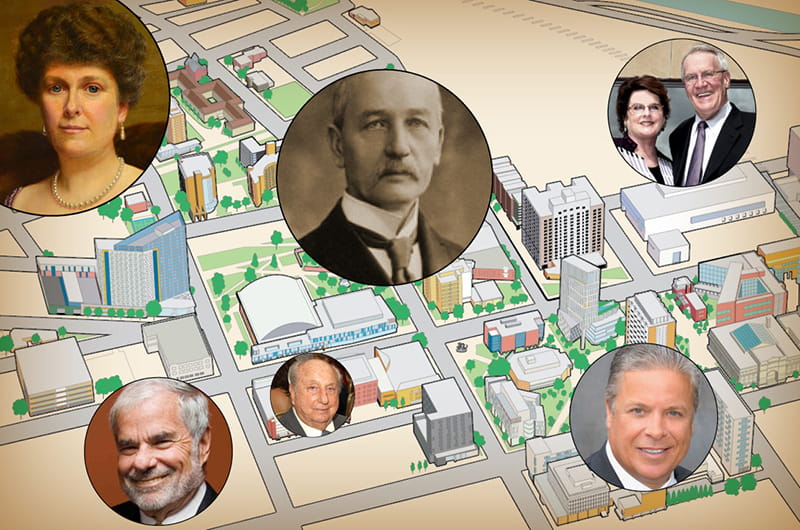
You pass by and enter these buildings every day, but do you know just who those halls and centers are named after on Drexel’s University City Campus?
Here are some fun facts about the people behind those Drexel buildings — because you’re probably (definitely) pronouncing Disque Hall wrong and likely can’t name the five Drexel presidents with buildings named after them on campus (and the one whose building is no longer).
Bossone Research Enterprise Center
In 2005, this building was built and named for Edmund D. Bossone ’48, ’53, HD ’07, a World War II veteran and former senior engineer at PECO who is a member of the Drexel 100, the University’s alumni hall of fame. The College of Engineering space was designed by the renowned architect I. M. Pei (using concepts he had previously developed for the Pyramide du Louvre in Paris).
Opened in 1962, this student hangout spot was originally called the Drexel Activities Center. In 1973, the name was changed in honor of James Creese, who stepped down as president of what was then the Drexel Institute of Technology that year after serving for 18 years in that position.
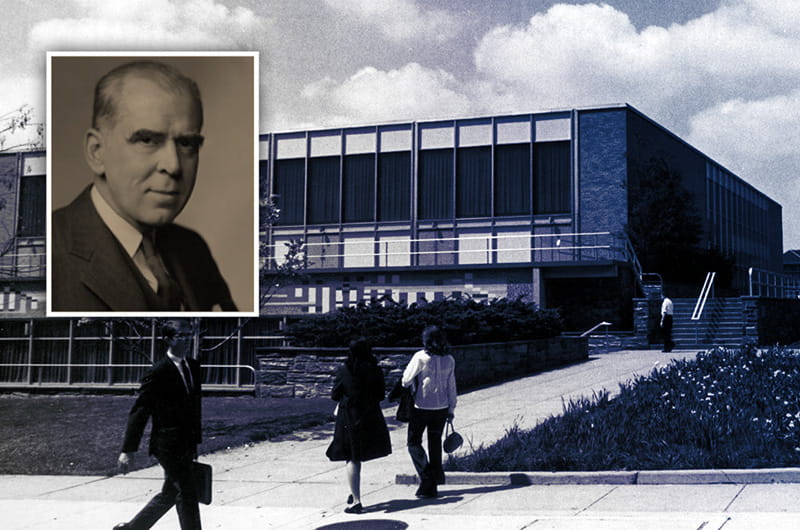
Curtis Hall
Curtis Hall opened in 1928 and was named after famed newspaper publisher and Drexel trustee Cyrus H. K. Curtis. He donated $750,000 to build what he told students was “another tool to help you to help yourselves,” and also donated the Curtis organ in the auditorium in Main Building.
Opened as the Physical Education Center in 1975, today’s “DAC” got a name change in 2000 in honor of John A. Daskalakis ’63, a longtime friend of Drexel Athletics (he was a star lacrosse player as a student) and member of the Drexel 100. “My dream was to provide a center on campus for all students so they can relax and simply have fun in a safe and clean environment, as well as to provide them a break between studies,” he said about the space.
Disque Hall
Chances are you’ve been pronouncing this College of Arts and Sciences building as “disk” rather than “DIS-kway,” as students would have done when its namesake, Robert C. Disque, was on campus. He started at the Drexel Institute of Art, Science and Industry in 1919 as a professor of electrical engineering. Disque served as interim Drexel president twice in the ’40s and retired as emeritus dean of the faculty and also the College of Engineering in 1953. The science tower was dedicated in his honor in 1967.
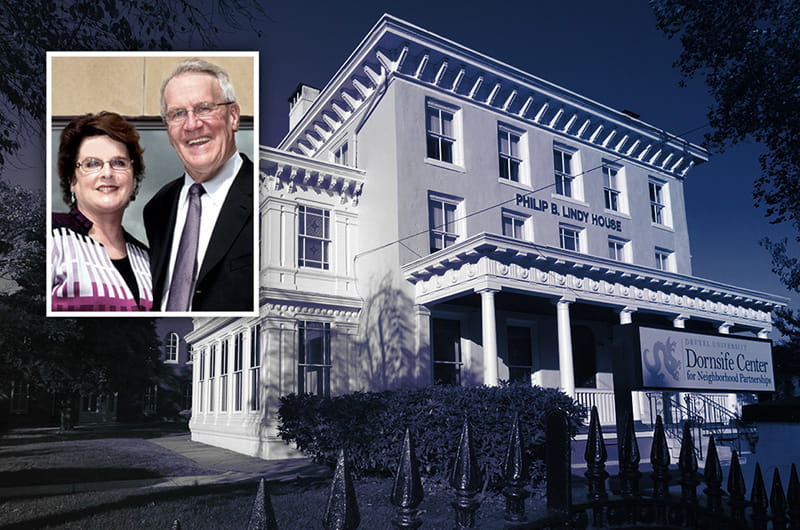
In addition to this community center named after philanthropists Dana and David Dornsife, there’s also the Dornsife School of Public Health and the Dana and David Dornsife Center for Experiential Business Education here at the University. Dana Dornsife received her bachelor’s degree in business in 1983 and is the founder, president and CEO of the Lazarex Cancer Foundation, which financially enables terminally ill cancer patients to participate in clinical trials and new treatments. She and her husband, a University of Southern California alumnus and trustee and chairman of the Herrick Corporation, both received honorary degrees from Drexel in 2014.
The W.W. Hagerty Library on the corner of 34th and Market streets opened in 1983 in honor of President William W. Hagerty, Drexel’s longest serving president (1963–1984).
Also known as the “Hans,” this dining establishment was opened in 1990 and named for Albert Handschumacher ’41, a powerful force in the manufacturing aspect of the aviation industry. The World War II veteran and outstanding alumnus was a longtime Drexel trustee and member of the Drexel 100.
The Korman Center, which originally opened in 1959 to house Drexel’s library, got its name in 1977 in honor of alumnus Max W. Korman ’29 and his brother, alumnus and trustee Samuel J. Korman ’34 (pictured), leader of the family’s development firm. About four decades later, the Hyman Korman Family Foundation made a gift to update the building and the adjacent Korman Quad.
LeBow Engineering Center

This College of Engineering building is named for Bennett S. LeBow ’60, HD ’98 — a last name familiar to business students at Drexel. In 1999, 10 years after the building opened, it was named for the current chairman of the board of the cigarette company Vector Group Ltd. and inaugural Drexel 100 inductee.
Gerri C. LeBow Hall
Named for the late wife of LeBow, the 12-story building housing the LeBow College of Business and the Goodwin College of Professional Studies (and a Starbucks!) opened in 2013. Mrs. LeBow was the secretary of the Bennett S. and Geraldine C. LeBow Foundation and a major benefactor and board member of the Miami City Ballet and of the Adrienne Arsht Center.
Previously, the space had been the site of Matheson Hall, which was built in 1965, demolished in 2011 and named for Drexel’s President Kenneth G. Matheson, who presided over the Drexel Institute of Art, Science and Industry from 1922 to 1931.
James E. Marks Intercultural Center and James E. Marks Tower
Originally, the James E. Marks Intercultural Center opened on the former site of the Newman Center in 2010, but that spot is now home to the Study at University City hotel. Now, the interfaith spiritual center is located at 3225 Arch St. but it’s still named for Marks, who graduated with a bachelor’s degree in mechanical engineering in 1947 and a master’s in business administration in 1949. Marks also served on Drexel’s board of trustees from 1988 to 1995 and was elected an emeritus trustee in 1996. The James E. Marks Tower, part of Chestnut Square on 33rd and Market streets, opened in 2013.
MacAlister Hall
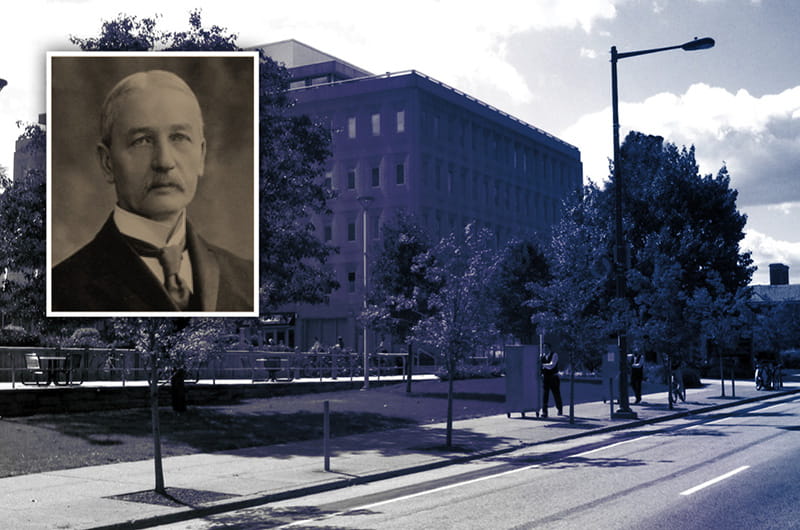
Formerly called the formerly Educational Activities Center and opened in 1973, today’s MacAlister Hall was named for James A. MacAlister, Drexel’s original president, who presided over the Drexel Institute of Art, Science and Industry in its first 22 years.
Nesbitt Hall
Today’s home of the Dornsife School of Public Health is named after Albert Nesbitt, president of John J. Nesbitt Inc., which was then a leading manufacturer of heating, ventilating and air conditioning units for schools. Nesbitt was a longtime friend of Drexel: he had studied engineering at the evening school, received an honorary degree in 1952 and was a member of Drexel’s Board Trustees from 1953 to 1970, serving as Chairman of the Board from 1966 to 1968. Two years later, Nesbitt Hall opened; and shortly after, the College of Home Economics was renamed the Nesbitt College of Design, Nutrition, Human Behavior, and Home Economics (which became the Nesbitt College of Design Arts in 1985, the College of Design Arts in 1998 and today’s Antoinette Westphal College of Media Arts and Design in 2005).

Commonly called “PISB,” the Constantine N. Papadakis Integrated Sciences Building (the one with the Saxbys and the biowall) was named after the Drexel president who served before its current president, John Fry. Papadakis presided over the University from 1995 to 2009. Two years after his death, the College of Arts and Sciences building opened in 2011.
Leonard Pearlstein Business Learning Center and Leonard Pearlstein Gallery
Leonard Pearlstein was the founder of Confab Inc., the country’s largest private-label manufacturer disposable diapers, incontinence products and sanitary pads. He served as a Drexel trustee from 1992 until his death in 1996; afterwards, his widow Melba Pearlstein served on the board from 1998–2003 (and was an emeritus trustee until her death in 2016) and his daughter, Abbie Dean ’07, has been a trustee since 2004.
The Leonard Pearlstein Business Learning Center, which opened in 2002, houses the Close School of Entrepreneurship and was used by students in the LeBow College of Business (and those seeking caffeine at Starbucks).
In 2003, Pearlstein’s family named the Westphal College of Media Arts & Design’s gallery space in his honor (it had been founded in 1986 as Drexel’s Design Arts Gallery). In 2011, it moved from its place in Nesbitt Hall to its current location in Drexel’s URBN Annex at 3401 Filbert St.
The building was built by noted Philadelphia architect Frank Furness as the Centennial National Bank in 1876 to serve as the fiscal agent of the Centennial Exposition. The space was named to the National Register of Historic Places in 1971, and Drexel purchased it five years later. It was renovated and opened in 2001 as the Paul Peck Alumni Center, named to honor alumnus Paul Peck ’64, an information technology consultant. Now, the building is used for office space and exhibit art from The Drexel Collection.
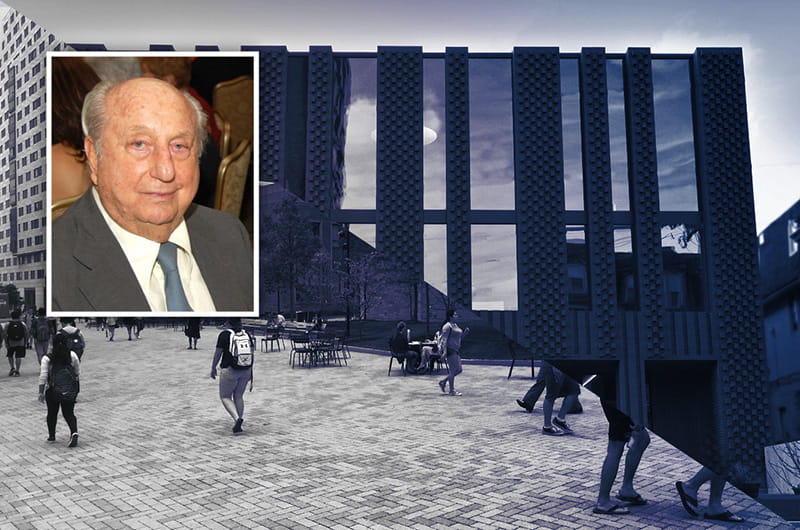
The Raymond G. Perelman Center for Jewish Life opened in 2016 thanks to a major gift from Raymond G. Perelman HD ’12, a local philanthropist and founder, chairman and CEO of RGP Holdings. The Raymond G. Perelman Plaza, located along the former 32nd Street between Market and Chestnut streets, was also named for him and opened in 2014.
Randell Hall
Originally called East Hall when it opened in 1902, Randell Hall was renamed in 1924 as Randell Hall in honor of two sisters, Letitia Randell Garrison and Lillie Bell Randell (pictured), who was a lifelong friend of Anthony J. Drexel’s daughter Sarah Drexel Van Rensselaer.
Residence Halls
- Bentley Hall: Still under construction, the forthcoming Bentley Hall (named after Greg S. Bentley, CEO of Bentley Systems, and his wife Caroline) is taking the place of Calhoun Hall, which was constructed in 1972 and named after Cynthia Calhoun HD ’82, and her husband Ernest N. Calhoun, class of 1918. At first, the building was referred to the Kling dorm, named after its famous architect designer Vincent Kling.
- Caneris Hall: Called the East Hall dormitory when it opened in 2000, the building was renamed in honor of Anthony T. Caneris, who was Senior Vice President for Student Life and Administrative Services at Drexel.
- Kelly Hall: Drexel’s first men’s dormitory opened in the ’60s in honor of Ralph Kelly, who had served as Commissioner of Customs in the Eisenhower Administration and was a prominent industrialist, civic leader and civil servant. His wife Ethel Burgess dedicated the building in honor of his benefaction in 1969.
- Myers Hall: This dormitory opened in 1977 and was named in honor of Harold M. Myers ’38, HD ’83, who was at Drexel for six decades in multiple capacities, including interim president in 1987.
- Van Rensselaer Hall: Drexel’s first dormitory opened as a dorm for women in 1931. It was named in honor of Sarah “Sallie” Drexel Van Rensselaer, the founder’s daughter and a prominent socialite and philanthropist. She was fiercely proud and protective of her father’s institute and legacy: she advocated for physical training for women and children at Drexel, was a member of the Drexel Institute of Art, Science and Industry’s advisory board of women in its first few years and in 1905 presented the bust of Anthony J. Drexel now positioned on the stairwell overlooking the Great Court in Main Building.
This mansion was constructed in 1888 and was owned by railroad magnate Max Riebenack, III; the house stayed in his family until 1928, when Drexel acquired it and some surrounding land. A year later, it became the Home Management House for women in the Domestic Science and Arts Department, and a nursery school was located on the first floor for students to practice childcare training. It was later named the Grace Godfrey Home Management House in honor of the late dean of home economics. In 1991, an electrical fire closed the building for a decade until alumnus, member of the Drexel 100 and former chairman of the Board of Trustees George Ross ’55, Hon. ’99, and his wife, Lyn, donated funding to renovate the estate. It opened in 2003 as Ross Commons and features two eateries (Sabrina's Café and Spencer's Burgers) on the first level and recreational and meeting space on the second floor.
Stratton Hall
The former Basic Science Building built in 1955 was renamed Stratton Hall in 1967 in honor of Leon D. Stratton, who started at Drexel as a chemistry instructor in 1909 and retired in 1952 as dean emeritus of students, dean emeritus of men and former dean of alumni.
Drexel News is produced by
University Marketing and Communications.

